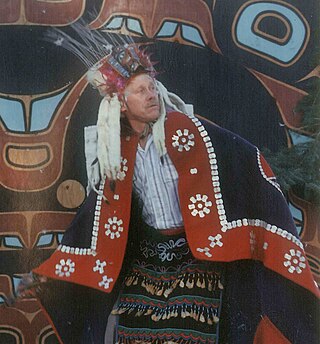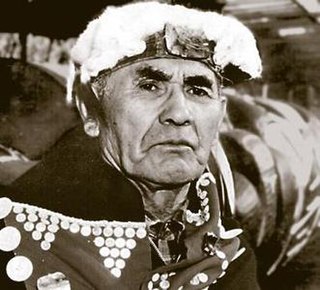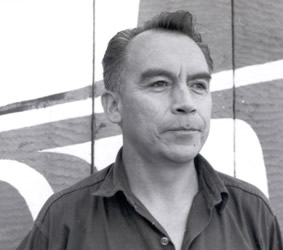David Anthony Neel (born April 7, 1960) is a Canadian writer, photographer, and artist who is a member of the Kwakwaka'wakw First Nation of coastal British Columbia.
Contents

David Anthony Neel (born April 7, 1960) is a Canadian writer, photographer, and artist who is a member of the Kwakwaka'wakw First Nation of coastal British Columbia.

Neel was born on April 7, 1960, in Vancouver, British Columbia. He is a Canadian multi-media artist from Fort Rupert, British Columbia, known for his ability to work in number of media. He trained as a professional photographer in the United States for several years before returning to Vancouver in 1987. This was a turning point as he soon began working in the style of his father's people, the Kwakwaka'wakw.
From 1987 to 1989, he apprenticed with Kwakwaka'wakw carvers, Beau Dick and Wayne Alfred. He was following in the footsteps of his late father, Dave Neel Sr. (1937–1961), who was trained by his mother, Ellen Neel (1916–1966), who was trained by her uncle, Mungo Martin (1881–1962) and her grandfather, Charlie James (1875–1938). In this way he was carrying on a long-standing family tradition.

In the 1990s he went on to develop a highly personalized and controversial style of carving, using masks to comment and editorialize contemporary history and society. He came to believe that "tradition is a foundation to build upon, not a set of rules to restrain creativity." Examples of these masks are the "Mask of International Commerce," which was exhibited in London, England, for the Royal Opening of Canada House, and the "Mask of the Injustice System," which was exhibited at the 1999 Venice Biennale. [1] For the Biennale, Neel exhibited his contemporary masks in a site-specific installation and did a performance on the Grand Canal using his 26-foot dugout canoe, the "Walas-Kwis-Gila" (Travels Great Distances). Following the publication of The Great Canoes in 1995, he carved two canoes; a 26-foot and 32-foot, which were used on a number of canoe journeys.
Also in the 1990s Neel produced a number of limited edition prints, some of traditional Kwakwaka'wakw subjects and others of dealing with contemporary history, much like the masks. The best known of these is Life on the 18th Hole, which portrays a Mohawk warrior from the 1990 Oka Crisis in Quebec, Canada.
His original media, photography, resulted in two books about Native culture: Our Chiefs and Elders in 1992 and The Great Canoes in 1995. Like the prints and masks, these also dealt with contemporary Native history. He continued to work as a professional photographer, specializing in contemporary Native people. Major commissions include a series of portraits for the National Museum of the American Indian, New York, New York, in 1992, and a permanent installation of his portraits in the Mashantucket Pequot Museum, Groton, Connecticut (2001–2008).
In 1991 he began hand engraving jewelry in the Kwakwaka'wakw style, working in silver, gold and platinum. From 1998 to 2000 he did a series of elaborate gold and silver boxes, inspired by traditional bentwood cedar chests. He continues to work in jewelry, working primarily with gold and diamonds.
His work came full circle in 2000 when he began painting on canvas, the media of choice of his late father. The paintings, oil and acrylic paint on canvas, originally dealt with traditional legends in a highly personalized style. Following this series he evolved into abstractions and later stylized depictions of masks from museum collections. Neel continues to be an active artist, working primarily in jewelry and painting.
In both 1987 and 1988, Neel earned the Mungo Martin Memorial Award. In 1991 Canada Council Explorations provided him with a grant for his Contemporary Mask Series. The Smithsonian Institution awarded him a Community Scholar Grant in 1992. [2] The Way Home, his memoir of his experience reconnecting with his indigenous heritage, was shortlisted for the 2020 Hilary Weston Writers' Trust Prize for Nonfiction. [3]

William Ronald Reid Jr. was a Haida artist whose works include jewelry, sculpture, screen-printing, and paintings. Producing over one thousand original works during his fifty-year career, Reid is regarded as one of the most significant Northwest Coast artists of the late twentieth century.

The Kwakwa̱ka̱ʼwakw, also known as the Kwakiutl, are one of the indigenous peoples of the Pacific Northwest Coast. Their current population, according to a 2016 census, is 3,665. Most live in their traditional territory on northern Vancouver Island, nearby smaller islands including the Discovery Islands, and the adjacent British Columbia mainland. Some also live outside their homelands in urban areas such as Victoria and Vancouver. They are politically organized into 13 band governments.

Oscar William Holm Jr. was an American art historian and author, focused on Indigenous Northwest Coast art. He created artworks and taught Northwest Coast style, including formline design. He was Professor Emeritus of Art History, and Curator Emeritus of Northwest Coast Indian Art at the Burke Museum of Natural History and Culture and occasionally lectured at the University of Washington in Seattle.

Northwest Coast art is the term commonly applied to a style of art created primarily by artists from Tlingit, Haida, Heiltsuk, Nuxalk, Tsimshian, Kwakwaka'wakw, Nuu-chah-nulth and other First Nations and Native American tribes of the Northwest Coast of North America, from pre-European-contact times up to the present.

Chief Mungo Martin or Nakapenkem, Datsa, was an important figure in Northwest Coast style art, specifically that of the Kwakwaka'wakw Aboriginal people who live in the area of British Columbia and Vancouver Island. He was a major contributor to Kwakwaka'wakw art, especially in the realm of wood sculpture and painting. He was also known as a singer and songwriter.

Henry Hunt was a First Nations woodcarver and artist from the Kwakwaka'wakw people of coastal British Columbia. He carved a number of totem poles which are on public display in Canada and internationally.

The visual arts of the Indigenous peoples of the Americas encompasses the visual artistic practices of the Indigenous peoples of the Americas from ancient times to the present. These include works from South America and North America, which includes Central America and Greenland. The Siberian Yupiit, who have great cultural overlap with Native Alaskan Yupiit, are also included.
Ron Joseph Telek was a Canadian First Nations sculptor. He is a member of the Laxsgiik of the Nisga'a nation of northwestern British Columbia, and carries the hereditary name of Jagam Txalp meaning Four Canoes Coming into the Village. Telek's primary medium for his sculptures is wood, although he also includes other materials such as bone, moose hair and abalone into his work.
Willie Seaweed was a Kwakwaka'wakw chief and wood carver from Canada. He was considered a master Northwest Coast Indian artist who is remembered for his technical artistic style and protection of traditional native ceremonies during the Canadian potlatch ceremony ban. Today, Seaweed's work can be found in cultural centers and corporations, art museums, natural history museums, and private collections. Some pieces are still in use by the Nak'waxda'xw tribe.

Ellen Neel (1916–1966) was a Kwakwakaʼwakw artist woodcarver and is the first woman known to have professionally carved totem poles. She came from Alert Bay, British Columbia, and her work is in public collections throughout the world.

Kwakwaka'wakw art describes the art of the Kwakwaka'wakw peoples of British Columbia. It encompasses a wide variety of woodcarving, sculpture, painting, weaving and dance. Kwakwaka'wakw arts are exemplified in totem poles, masks, wooden carvings, jewelry and woven blankets. Visual arts are defined by simplicity, realism, and artistic emphasis. Dances are observed in the many rituals and ceremonies in Kwakwaka'wakw culture. Much of what is known about Kwakwaka'wakw art comes from oral history, archeological finds in the 19th century, inherited objects, and devoted artists educated in Kwakwaka'wakw traditions.

Mildred Valley Thornton was a Canadian artist most well known for her portraits of First Nations people. She also painted landscapes in oil and watercolour. Her paintings were usually done in vivid colours. Born in Ontario, she moved to Regina in 1913, and began painting Indigenous portraits fifteen years later. Her portraits were completed quickly, usually under one hour. In 1934, she relocated to British Columbia, and continued to paint individuals of that province's aboriginal population, eventually amassing nearly 300 portraits. Thornton was a tireless lecturer and advocate of Indigenous and women's rights. While lecturing, she often appeared dressed in buckskin, and played Indigenous songs that she had recorded. Besides being an author and art critic, she was involved in numerous literary and artistic associations. She hoped to sell her portrait collection to the Government of Canada, and when this wasn't forthcoming, decreed in her will that it be burned. The portraits narrowly escaped that fate due to a technicality. While popular in her lifetime, Thornton was neglected for some time afterwards. A biography of her by Sheryl Salloum was published in 2011. There has been mixed reactions to her work and persona among First Nations peoples, with some collecting portraits of their ancestors and others regarding Thornton through the lens of cultural appropriation.
Doug Cranmer (1927–2006), also known as Pal'nakwala Wakas and Kesu', was a Kwakwaka'wakw carver and artist as well as a 'Namgis chief. Cranmer was a significant figure in the Northwest Coast art movement, both in its traditional form and in a modern contemporary form that he created and developed.

Beau Dick was a Kwakwaka'wakw Northwest Coast artist and Chief who lived and worked in Alert Bay, British Columbia, Canada. He was a contemporary artist, activist and hereditary Chief from the Namgis First Nation. Dick was an artist with an extensive national and international exhibition history.
Mary Anne Barkhouse is a jeweller and sculptor residing in Haliburton, Ontario, Canada. She belongs to the Nimpkish band of the Kwakiutl First Nation.
Phil Gray is a Canadian artist who specializes in wood carvings from the Tsimshian and Mikisew Cree communities. His work uses traditional technique and features imagery from legends. In 2014, Gray was awarded a British Columbia Creative Achievement Award in Aboriginal Art from the Government of British Columbia.
Lawrence Paul Yuxweluptun is a Cowichan/Syilx First Nations contemporary artist from Canada. His paintings employ elements of Northwest Coast formline design and Surrealism to explore issues as environmentalism, land ownership, and Canada's treatment of First Nations peoples.

Marianne Nicolson is a Dzawada’enuxw visual artist whose work explores the margins at which public access to First Nations artifacts clashes with the preservation of indigenous cultural knowledge. She utilizes painting, photography, mixed-media, sculpture, and installation to create modern depictions of traditional Kwakwaka’wakw beliefs, and has exhibited in Canada and throughout the world since 1992.

Douglas Reynolds Gallery is an art gallery in Vancouver, British Columbia, Canada. It is located in the Business Improvement Area of South Granville. The gallery was founded in 1995 by Douglas Reynolds.
Henry Speck was a Tlawit'sis (Kwakwaka'wakw) painter, carver, and dancer.